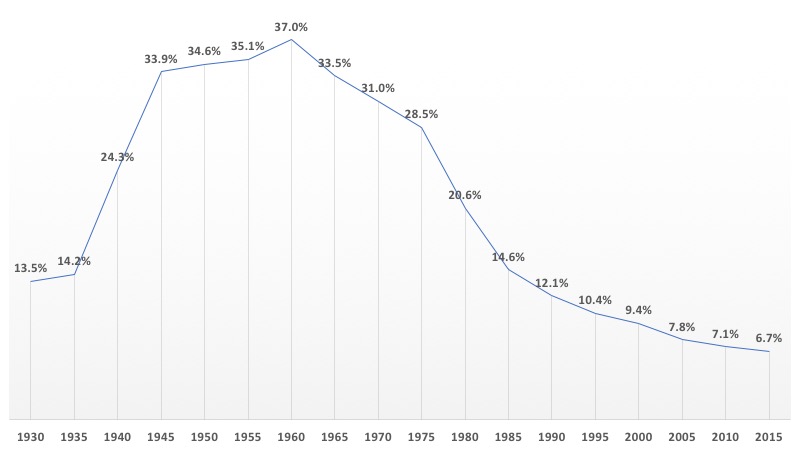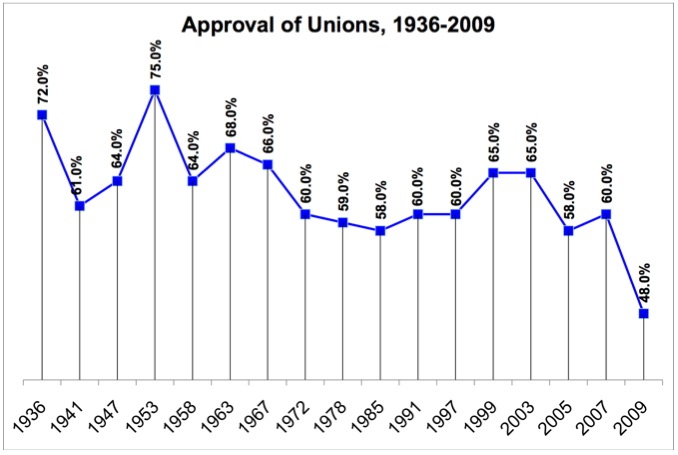%
As recently as 2009 fewer than half of all Americans held a favorable opinion of unions.
A Short History of Unions
Labor unions played a role in our country’s history, especially during the industrial revolution. Unions struggled mightily during the industrial revolution, fighting for things we take for granted today, like banning the use of child labor.
Unions faced massive opposition by employers including strong-arm tactics like the use of court injunctions, private security guards and even bringing in the National Guard to stop strikes. These were tumultuous times.
After the Great Depression unions began to slowly increase their membership. They had a strong ally in Franklin Roosevelt and eventually were able to get legislation passed that provided – for the first time – legal protection for organizing. Union membership exploded in the 1930s and 1940s. Almost 36% of American workers were represented by unions in 1945. But in the last 25 years unions have declined dramatically.

Just take a look at the following graph. Union membership has been steadily declining in the US since 1983. Today only around 11% of American workers belong to a union – and most of those are public employees. The rapid growth of public employee unions since the 1960s masks an even more dramatic decline in private-sector union membership. Today less than 7% of private sector employees belong to unions.
There are many reasons for the decline of union membership over the last 25 years. Heavily unionized industries (like steel manufacturing, the automobile industry, textiles) were not able to adjust and compete in an increasingly competitive world economy. In the trucking industry deregulation had the same effect. More agile and efficient non-union competitors were able to beat out unionized companies and those union members often moved on to non-union companies.
Economic conditions only explain part of the reason for the decline in union membership. There is also less demand for the services unions provide. Today there are federal laws that deal with discrimination, harassment (EEOC), workplace safety (OSHA), fair pay (FLSA), family and medical leave (FMLA) and many other issues. Many of the things that used to be in union contracts are now available to all workers.
Unions have also had their share of problems, too. Union corruption, including highly publicized ties to organized crime (the Teamsters remain under federal supervision even today as they try to rid their union of these problems) have made many potential members reluctant to join. The recent bailout of the auto industry also highlights the burdens that some union contracts can put on a company, making it nearly impossible to compete. In fact, in 2009 and for the first time since data has been gathered, fewer than half of all Americans held a favorable opinion of unions.

Finally, most companies today work hard to create a positive work environment. This is a source of competitive advantage for many companies – Progress Rail is certainly one of them. We know that even in a down economy, it is the quality of our people that helps us to beat the competition. We have to attract the very best talent out there, and one way we do that is by providing a great work environment with highly competitive pay and benefits. We also strive to make sure that our employees have a positive and productive relationship with their coworkers – especially their supervisor.
Back when the average working conditions in the country were horrible and union membership was at its peak, the choice between union and non-union was much easier than it is today. In today’s competitive economy, where companies work hard to provide a good work environment (and many union companies are on the ropes of going bankrupt), most people don’t see the value in paying dues to a union, particularly when members have very little input on how unions will spend that money. So it is not surprising that union membership is on the decline.
This website is provided as a resource for you and your family, as you consider whether or not to support union organizing efforts.
Whether to unionize is an extremely important decision. If voted in, a union would speak for you regarding all terms and conditions of your employment, including:
- your current and future pay
- the cost and structure of your health and other insurance plans, retirement plan and other benefits you currently enjoy
- your holidays, vacation and other forms of paid and unpaid leave
- whether many employment-related decisions are based on your merit, or simply upon your date of service
- whether you will have union dues deducted from your paycheck, and how much?
- the potential for strikes and possible permanent replacement during an economic strike